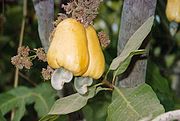 It’s National Cashew Day. Today will be informative, but brief.
It’s National Cashew Day. Today will be informative, but brief.
The cashew is a tree in the flowering plant family Anacardiaceae, and it’s native to northeastern Brazil. The name derives from the Portugese name for the fruit of the cashew tree, caju, which in turn derives from an indigenous name, acajú, so it’s a derivative of a derivative. In Indonesia it’s named “Jambu Monyet”, because the cashewnut apparently looks like a monkey hanging on something. The tree is now cultivated in many regions where there is sufficient warmth and humidity for proper growth. Vietnam, NIgeria, India and Brazil produce 90% of the world’s crop of cashews.
The actually nut produced from the tree is a secondary fruit that forms at the end of the cashew apple, known as a pseudofruit, a thin skinned fruit also known as a maranon. The pulp is sweet and juicy but the skin of the fruit breaks easily making it unsuitable for transport. The single seed is grown inside a double shell that contains the same potent skin toxin as poison ivy and often creates an allergic reaction in some to the cashew. Although we see it as a nut, a cashew is really a seed.
Cashews are rich in copper, magnesium and zinc- all containing antioxidant properties, but a serving of 18 nuts has 12 grams of fat containing 2.5 grams saturated. Yes, they are delicious and decadent. This is one of those items where the phrase ‘Everything in moderation’ really does apply. They figure prominently in Thai and Chinese cuisine, and are primarily ground for sauces in Indian cuisine. They can be used in a vegan diet as a substitute for cheese.
